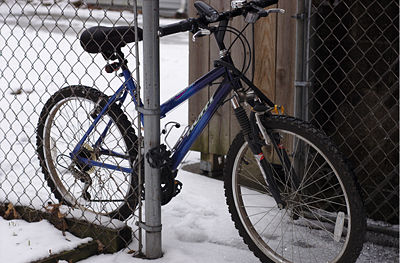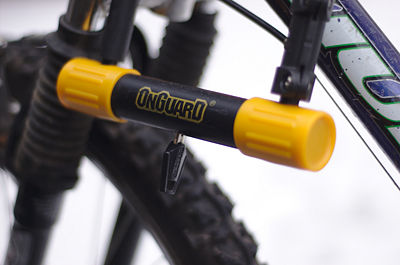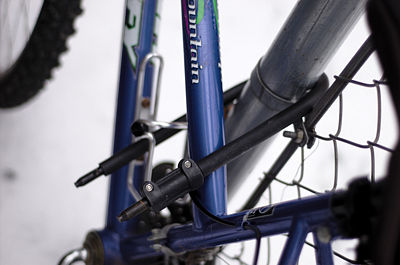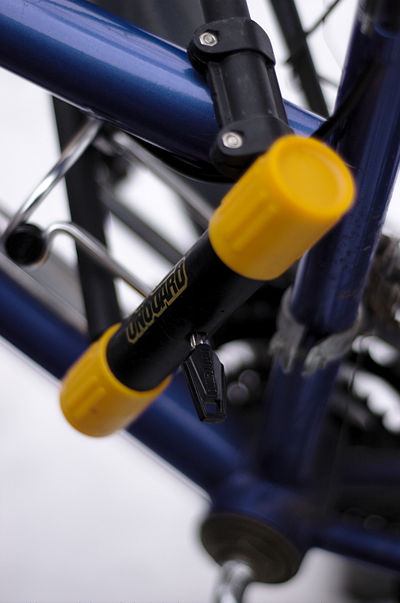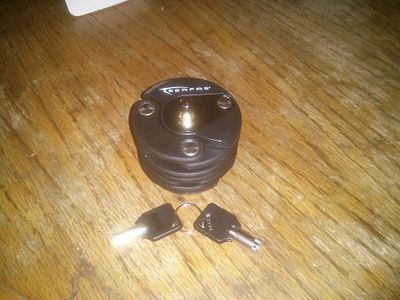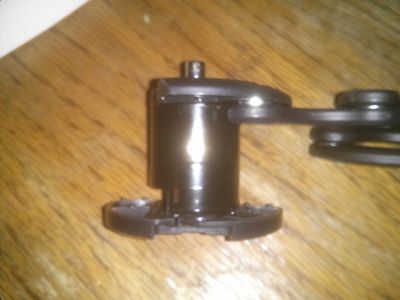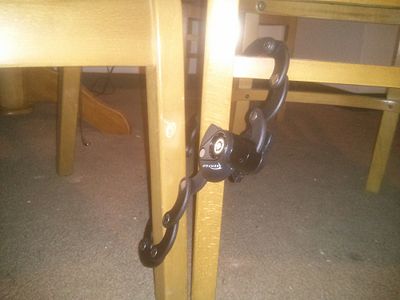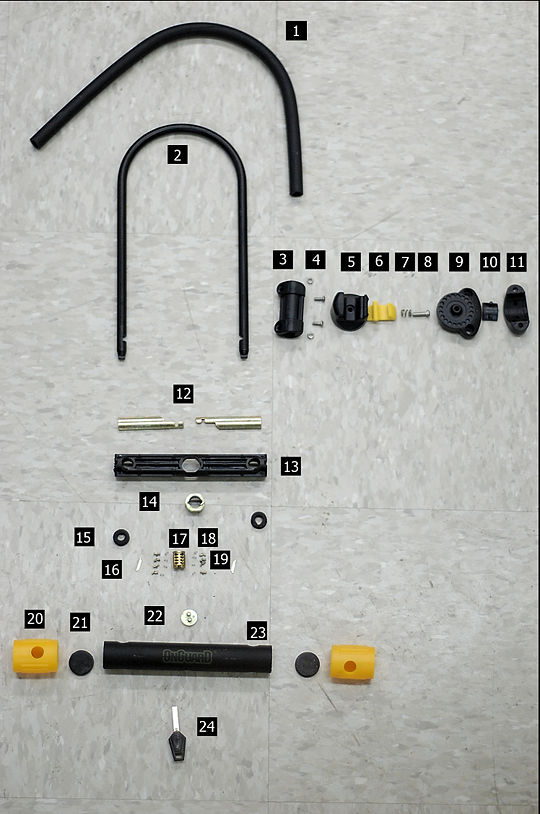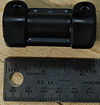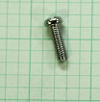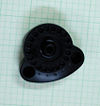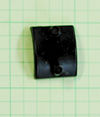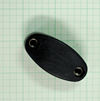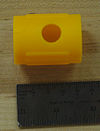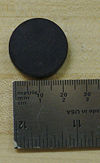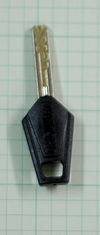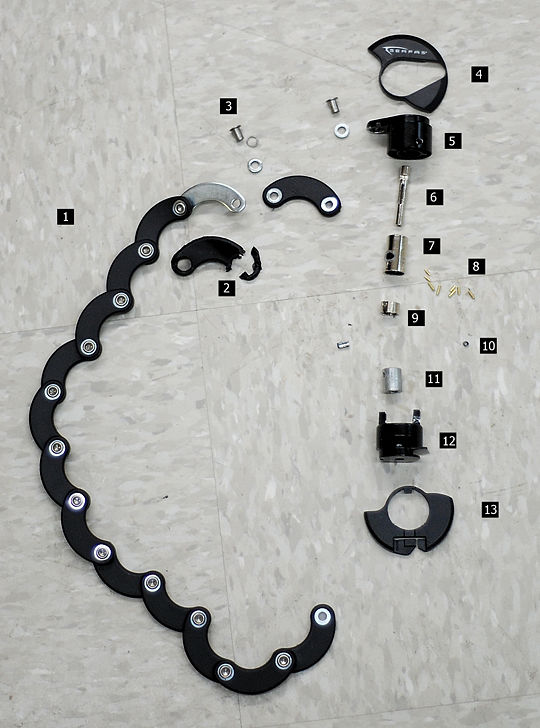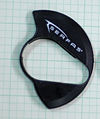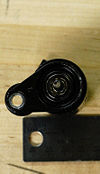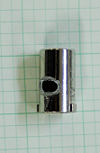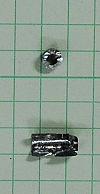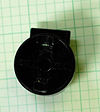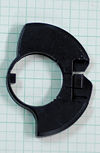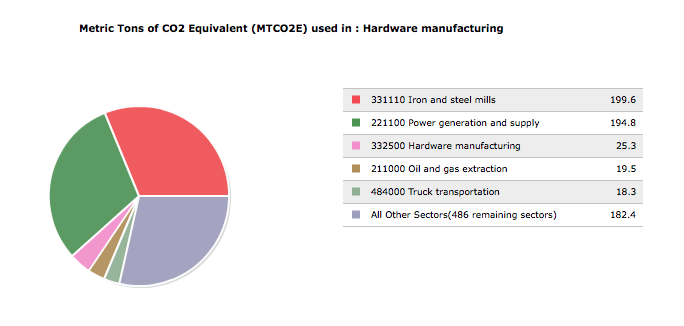Bike lock
From DDL Wiki
(→Puck Lock) |
(→Puck Lock) |
||
| Line 658: | Line 658: | ||
| align="center"|'''Minimize Fasteners''' | | align="center"|'''Minimize Fasteners''' | ||
| Strengths: | | Strengths: | ||
| + | * Simple roll pins, a number of snap fit components, and a heavy reliance on press fit components are used to reduce the number of fasteners | ||
| + | * A number of bumps and depressible plastic extensions are used to fix removable parts in place | ||
|- | |- | ||
| align="center"|'''Minimize Handling''' | | align="center"|'''Minimize Handling''' | ||
Revision as of 17:43, 2 February 2014
Contents |
Executive Summary
Product Stakeholder Analysis
Product Usage Study
U-Lock
First, the user will place their bike next to a locking structure. The user will unlock the U-Lock, place the U around the locking structure and the bike frame, then they will return the base to the U-Bar and remove the key. The bike frame is now secured to the locking structure.
Possible User Issues
Lock can only secure one part of the bike, most commonly the frame. The wheels are still unprotected with this. This constraint is due to the geometry of the U-Bar. It must be small enough to not be a burden to carry around, but must also be large enough to easily fit around most structures and the bike frame.
Some users do not use the included clamp, as it may not fit around every bike. They must find some other method of securing the lock to the bike.
Puck Lock
First, the user will place their bike next to a locking structure. The user will then unravel the chain around the puck lock. User will wrap the chain around the locking structure and as many parts of the bike as possible. (eg. frame and wheel) The user will then resecure the chain to the central lock cylinder and lock the lock.
Possible User Issues
Small chain makes it hard to connect multiple bike components. May leave some parts unsecured.
Bill of Materials
U-Lock
The following table contains information about each part labled in the above image.
| Part # | Name | Quantity | Subassembly | Mass [g] | Function | Material | Manufacturing Process | Image |
|---|---|---|---|---|---|---|---|---|
| 1 | Rubber Shielding | 1 | N/A | 68 | Provides weatherproofing for the U-Bar. It keeps dirt and grime out and prevents scratches. In comparison to the U-Bar it is plush and nice to the touch. | Rubber | Extrusion | |
| 2 | U-Bar | 1 | N/A | 330 | Can be placed around the chosen locking surface and the bike frame. This is then inserted into the base of the U-Lock and secures the bike to the locking surface. | Steel | Extruded, Bent, Cut | |
| 3 | U-Bar Clamp Attachment | 1 | Bike Frame Clamp | 15 | Provides nice mating surface for U-Bar and bike frame bracket. | Plastic | Injection Molding | |
| 4 | Frame Attachment Screws and Nuts | 4 | Bike Frame Clamp | 1 | Screws and nuts used to press clamp edges together around the U-Bar. | Steel | Off the Shelf | |
| 5 | U-Bar Frame Attachment Clasp | 1 | Bike Frame Clamp | 13 | Nicely holds onto the U-Bar and connects to a base piece that can be attached to a bike frame. | Plastic | Injection Molding | |
| 6 | U-Bar Frame Attachment Locking Tab | 1 | Bike Frame Clamp | 4 | Tab presses over edge of Clamp attachment on the U-Bar to secure it to the bike frame. | Plastic | Injection Molding | |
| 7 | U-Bar Frame Attachment Spring | 1 | Bike Frame Clamp | <1 | Spring sits under clasp and provides force on clasp to keep Lock attached to frame attachment. | Steel | Off the SHelf | |
| 8 | Frame Attachment Joining Screw | 1 | Bike Frame Clamp | <1 | Fastens the two major parts of the frame bracket together | Steel | Off the Shelf | |
| 9 | Frame Bracket Base | 1 | Bike Frame Clamp | 17 | Holds clasp. Has specific points of rotation so one can change the orientation of the clasp as it connects to the bike. Represents half of the frame bracket clamp. | Plastic | Injection Molding | |
| 10 | Mating Pad | 2 | Bike Frame Clamp | 2 | Snap in part is smooth and offers a nice mating surface between the clamp and the bike frame (Not Pictured), and the U-Lock and clamp. | Plastic | Injection Molding | |
| 11 | Bike Frame Bracket Clamp | 1 | Bike Frame Clamp | 18 | Part is placed around bike frame and fastened to the rest of the bracket via screws. Second half of frame bracket clamp. | Plastic | Injection Molding | |
| 12 | Locking Bars | 2 | Locking Mechanism | 26 | Bars fit into notches cut into the U-Bar. When they are in place they secure the U-Bar in place and prevent its removal. The hooks on either edge sit on nubs that rotate when the key is turned, sliding the locking bars back and forth. Typically coating is used on parts that slide around. | Steel | Forged and Coated with Titanium Nitrate | |
| 13 | Lock Component Housing Cylinder | 1 | Lock Mechanism | 28 | Neatly holds all the parts necessary to actually lock the lock. It has slots cut such that one cannot insert the lock upside down, tracks for the lock bars to slide on, and is designed such that all force imparted to the lock in an attempt to shock it open are directed around the lock bars. | Plastic | Injection Molding | |
| 14 | Lock Housing | 1 | Lock Mechanism | 15 | Housing is made to nicely keep the lock in place inside of the component housing cylinder. It has a tab to prevent incorrect insertion of lock. | Brass | Off the Shelf | |
| 15 | Rubber Grommet | 2 | N/A | <1 | Acts as both a seal to prevent dirt or water from entering the lock component housing cylinder, as well as a cushion to protect the cylinder from rubbing directly against the U-Bar | Rubber | Stamping | |
| 16 | Lock Stopper Pin | 2 | Lock Mechanism | <1 | Grooves in the lock housing fit around these spring loaded pins. When the key is concerned, These pins are compressed and allow the lock to turn. | Brass | Stamping | |
| 17 | Pin Housing | 1 | Lock Mechanism | 8 | Housing has space for spring and pins as well as the stopper pins and springs. Has a slot for a key to be inserted. Pin Housing will rotate around inside the lock housing. | Brass | Off the Shelf | |
| 18 | Pin Springs | 12 | Lock Mechanism | <1 | Pins sit on top of these springs. When the key is inserted and turned, these springs will compress or extend to get all the pins to the same height so the pin housing can rotate. They will return to their natural length after the key is removed. | Steel | Off the Shelf | |
| 19 | Pins | 8 | Lock Mechanism | <1 | These pins are each individually made with notches at a different height. The height of the notch corresponds to the pattern on the key. The correct key will line up with the notches, allowing the pins to be moved out of the way, allowing the pin housing. | Brass | Off the Shelf | |
| 20 | Plastic Endcap | 2 | N\A | 13 | Acts as a weatherproofing seal for the outer casing of the lock base. It also seals off the ends of the lock base via a tight fit, discouraging the user from tampering with the internals of the lock. Adds a stylistic element to the lock. | Soft Plastic | Molding | |
| 21 | Rubber Shock Absorber | 2 | N\A | 4 | Part acts as a weatherproofing seal as well as a shock absorber. Cushions any force that is applied to the ends of the lock. This prevents the lock from being bumped open. | Rubber | Stamping | |
| 22 | Lock Bar Actuator | 1 | Lock Mechanism | 3 | Slides into grove on back of pin housing. When pin housing rotates, this part rotates as well. The Lock Bars are attached to the nubs on top and turning the pin housing causes the lock bars to slide from unlocked to locked. | Brass | Off the Shelf | |
| 23 | Outer Housing | 1 | Lock Housing | 127 | A powder coated outer case that neatly houses the entire lock assembly. Has holes in it to accomodate the U-Bar ans well as a small hole in it, presumably for assembly alignment purposes. Coating adds plesant feel in comparison to unfinished steel. | Steel | Stamping and Welding | |
| 24 | Key | 5 | N\A | 6 | Key is specially made to line up with each of the pins in a specific lock. The track pulls the pins into the correct position, which allows the lock to rotate. | Steel and Plastic | Row 1, column 8 |
Puck Lock
The following table contains information about each part labled in the above image.
| Part # | Name | Quantity | Subassembly | Mass | Function | Material | Manufacturing Process | Image |
|---|---|---|---|---|---|---|---|---|
| 1 | Chain Link | 14 | Chain | 20 | Multiple links connected by pins allow for folding and extending of chain. Chain can be put around a locking structure and the bike frame in order to secure the bike to that structure. | Steel | Stamping | |
| 2 | Protective Plastic Cover | 14 | Chain | <1 | Provides weatherproofing for the links to reduce the likelihood of rust for each chain link. | Plastic | Injection Molding in 2 halves | |
| 3 | Pins and Washers | 13 | Chain | 3 | Connects chain links. Allows for smooth rotation of the links about the axis of the pin. | Steel | Off the Shelf | |
| 4 | Outer Plastic Cover | 2 | N\A | 5 | Covers outside of lock. Provides weatherproofing for the inner lock components. Provides a nice surface to the touch in comparison to the metal underneath. | Plastic | Two halves injection molded | |
| 5 | Upper Lock Housing | 1 | Lock Housing | 68 | Provides a place for the chain to lock to the lock body in a compact manner. This part is powder coated to prevent rust and wear. It protects the inner lock mechanisms from the elements. | Steel | Injection Molding | |
| 6 | Lock Actuator | 1 | Lock Housing | 8 | Spans the lock cylinder and holds everything together. This part is moved when the key is turned. | Steel | Off the Shelf | |
| 7 | Lock Housing | 1 | Lock Housing | 11 | Holds the two parts of the lock in a nice case. Its hard to break into, to prevent tampering. | Steel | Off the Self | |
| 8 | Pins | 8 | Lock Housing | <1 | Pins slide into the second pin housing. When they intersect the second pin housing, its impossible to rotate the pin housings. This is how the lock locks. | Brass | Off the Shelf | |
| 9 | Upper Pin Housing | 1 | Lock Housing | 4 | Second part of pin housing. Does not rotate. When the pins are extended into this piece, the housing cannot rotate. | Steel | Injection Molding | |
| 10 | Roll Pin | 2 | Lock Housing | <1 | Pins hold the two sides of the Metal lock housing together. These are very difficult to remove without advanced tools to prevent tampering. | Steel | Off the Shelf | |
| 11 | Lower Pin Housing | 1 | Lock Housing | 11 | Houses the pins and contains keyhole for the locking mechanism. When the pins are extended, they intersect the second part of the housing and prevent the housing from rotating. | Steel | Off the Shelf | |
| 12 | Lower Lock Housing | 1 | Lock Housing | 64 | Secures the lock parts and prevents tampering. | Steel | Injection Molding | |
| 13 | Lower Outer Plastic Cover | 1 | N\A | 7 | Provides weatherproofing and a nice surface to the touch for the lock | Plastic | Injection Molded |
DFMA
U-Lock
| Design for Manufacture Guidelines | ||
|---|---|---|
| Design Objective | Comments | |
| Minimize Part Count | Strengths:
Weaknesses:
| |
| Standardize Components | Weaknesses:
| |
| Commonize Product Line | Strengths:
| |
| Standardize Design Features | Strengths:
Weaknesses:
| |
| Keep Designs Simple | Strengths:
Weaknesses:
| |
| Multifunctional Parts | Strengths:
| |
| Ease of Fabrication | Strengths:
| |
| Avoid Tight Tolerances | Strengths:
Weaknesses:
| |
| Minimize Secondary and Finishing Operations | Strengths:
Weaknesses:
| |
| Take Advantage of Special Process Properties | Strengths:
| |
| Design for Assembly Guidelines | ||
|---|---|---|
| Design Objective | Comments | |
| Minimize Part Count | Weaknesses:
| |
| Minimize Assembly Surfaces | ||
| Use Subassemblies | Strengths:
| |
| Mistake-Proof | Strengths:
| |
| Minimize Fasteners | Strengths:
| |
| Minimize Handling | ||
| Minimize Assembly Direction | ||
| Provide Unobstructed Access | ||
| Maximize Assembly Compliance | ||
Puck Lock
| Design for Manufacture Guidelines | ||
|---|---|---|
| Design Objective | Comments | |
| Minimize Part Count | Strengths:
Weaknesses:
| |
| Standardize Components | Strengths:
Weaknesses:
| |
| Commonize Product Line | Strengths:
Weaknesses:
| |
| Standardize Design Features | Strengths:
| |
| Keep Designs Simple | Strengths:
Weaknesses:
| |
| Multifunctional Parts | Strengths:
| |
| Ease of Fabrication | Strengths:
Weaknesses:
| |
| Avoid Tight Tolerances | Strengths:
Weaknesses:
| |
| Minimize Secondary and Finishing Operations | Weaknesses:
| |
| Take Advantage of Special Process Properties | Strengths:
| |
| Design for Assembly Guidelines | ||
|---|---|---|
| Design Objective | Comments | |
| Minimize Part Count | Strengths:
Weaknesses:
| |
| Minimize Assembly Surfaces | Strengths:
Weaknesses:
| |
| Use Subassemblies | Strengths:
| |
| Mistake-Proof | Strengths:
Weaknesses;
| |
| Minimize Fasteners | Strengths:
| |
| Minimize Handling | ||
| Minimize Assembly Direction | ||
| Provide Unobstructed Access | ||
| Maximize Assembly Compliance | ||
FMEA
U-Lock
| Column 1 heading | Column 2 heading | Column 3 heading |
|---|---|---|
| Row 1, column 1 | Row 1, column 2 | Row 1, column 3 |
| Row 2, column 1 | Row 2, column 2 | Row 2, column 3 |
Puck Lock
DFE
This product has very minimal GHC emissions already due to the lack of energy or material consumption during product use. The primary contributer during the manufacturing to this is the production of steel followed closely by the energy consumption during manufacturing. While these are hard to reduce, considering lower energy machining processes or considering replacing some or all of the steel within the product with recycled aluminum could likely further lower the GHC emissions associated with product production.
A $30 CO2 tax would only effect product price by approximately 58 cents, a fairly insignificant cost change and would therefore be unlikely to effect product sales.
The one downside to these estimates is that they are not the most accurate representation of a bike lock manufacturing. While bike locks are similar in composition to the primary industries represented by Hardware Manufacturing, they are not one of the main representations within the category, dominated by furniture, builders' and motor vehicle hardware. Locks are represented in the second and third of those categories, but not specifically bike locks.
| Bike Lock Production | |
|---|---|
| Best Match economic sector number | 332500: Hardware Manufacturing |
| Reference Unit | 1 unit |
| Units consumed per product life | 1 unit |
| Cost per unit (2002 $) | $30.89 |
| Lifetime Cost | $30.89 |
| Economy-Wide mtCO2e Released per $1M of Output | 640 |
| Implied mtCO2 per Product Life | $0.0197696 |
| CO2 tax @ $30/mtCO2e | $0.593088 |
Group
Team Leader and FMEA Lead - Jeremy Jiang
Bill of Material - Ryan Chang
DFMA Leads - Rachel Chow and Alex Munoz
DFE Lead - Melissa Mann
